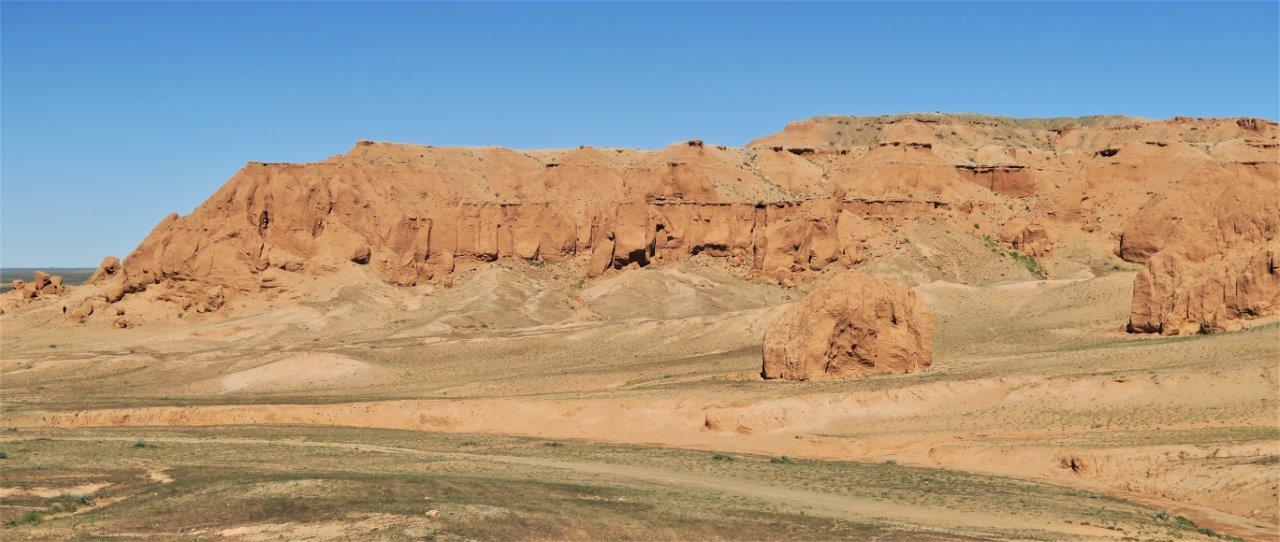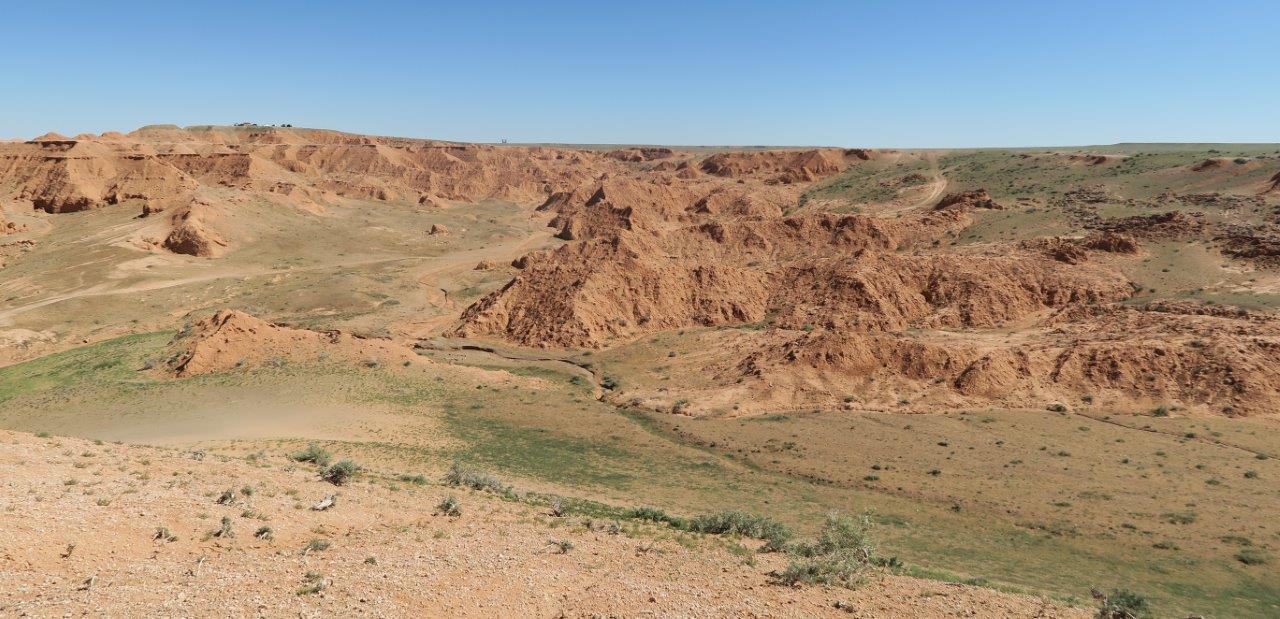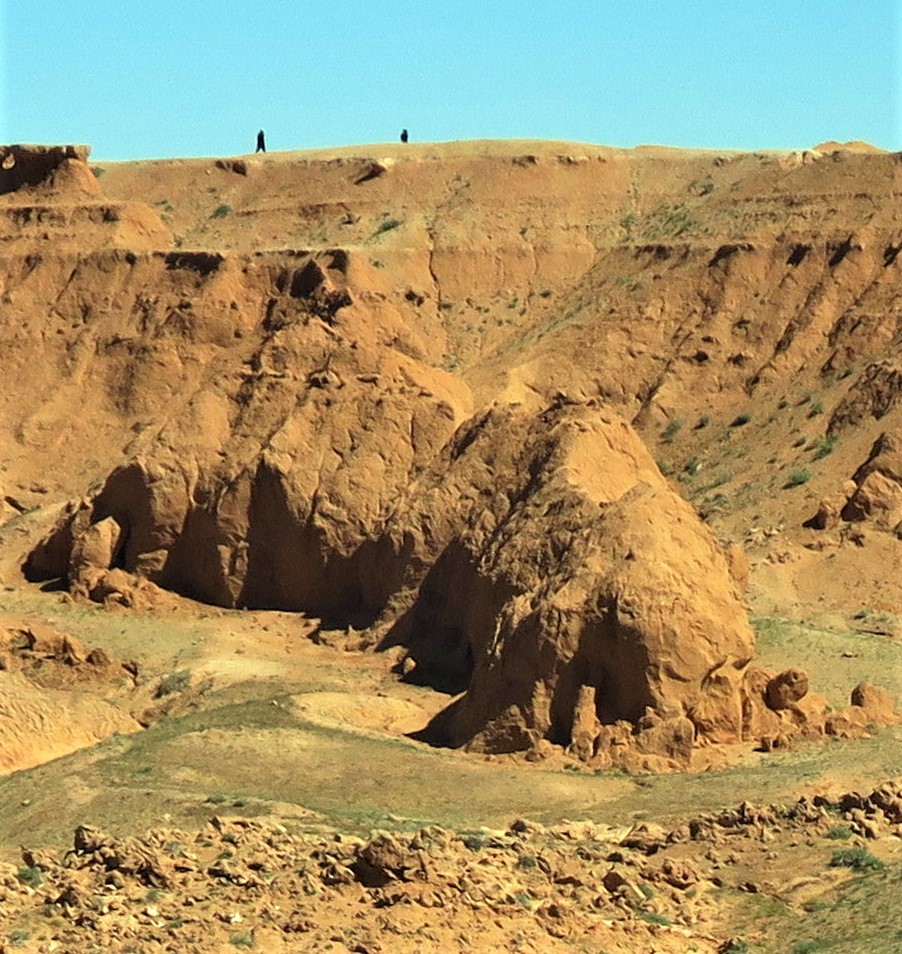One great sculptured wall we named the “Flaming Cliffs,” for when seen in early morning or late afternoon sunlight it seemed to be a mass of glowing fire.
The New Conquest of Central Asia
by Roy Chapman Andrews

The sandstone rocks of Bayanzag are popularly known as the ‘Flaming Cliffs’, due to the reddish tint in the soil that changes into a myriad of fiery shades when touched by the sun.
Sunrise and sunset are the best times to see the cliffs ‘blazing’ red and orange against the green valley below. Best views are from below or across the escarpment.
Bayanzag means ‘rich in saxaul’, so named for the tree-like shrubs dotting the surrounding landscape, one of the few plants that can survive the extremely arid, hot & cold of the Gobi Desert.


Walk The Land Of The Dinosaurs
Millions of years ago, dinosaurs roamed freely here, calling the vast desert landscape of rock, red sands, scrub and awesome nothingness, home.
This amazing discovery was made by Roy Chapman Andrews who arrived in 1922 to excavate the area.
The first Protoceratops skull was unearthed by team member James Shackelford, a cinematographer. Subsequently, with Andrew’s first-ever discovery of dinosaur eggs in 1923, Flaming Cliffs became famous, making news headlines all over the world.

Andrews led some of the biggest dinosaur skeleton hunting explorations from 1922 to 1928, describing it as a paradise for the palaeontologist, with fossil beds full of dinosaur bones and eggs.
Like a magnet, Flaming Cliffs attracted numerous archaeological and paleontologist expeditions, to discover the life cycle of dinosaurs and mammals from embryo to adults.



After a 5-hour drive from Khongor, we arrived shortly after 2pm. From the top of the escarpment, we had an expansive view of the barren rocks jutting out from the canyons below.
Appearing to rise out from great rifts on the earth, the sandstone red cliffs is an ancient formation of sand deposits and calcareous matter, created approximately 71 – 75 million years ago, and mostly unchanged, today.



One of them we named the “dinosaur,” for it resembles a huge Brontosaurus sitting on its haunches.
Could Andrews have been describing the formation above (left picture) in his book, you think?
We wasted no time exploring the cliffs, plunging down from the rim to the bottom, wandering around the paleontological rich Flaming Cliffs, hoping to find fragments of dinosaur bones buried in the soil.
NB. No digging or removal of fossils is permitted.


If you have an hour to spare, you can hike the trails on the rim for birds-eye views from the top of the highest cliffs. Weaving along the edge of the cliff, the only uphill portions – to get to the next plateau – are short with very little elevation gain.
The takeaway – different views of the rock formations once inhabited by dinosaurs.
Bayanzag Flaming Cliffs Located in the northern part of Mongolian Gobi Desert in a vast sedimentary basin, Bayanzag is a valley covered by ancient deposits with saxuals and combination of Gobi landscape, rocks and taluses. It is situated 17km away from Bulgan soum of Umnugobi province, 597km south west of Ulaanbaatar city. American explorer, adventurer and naturalist Roy Chapman Andrews first discovered dinosaur eggs here in 1923, while leading several expeditions in the early 20th Century. Andrew's discoveries include the world's first fossilized dinosaur eggs, petrified forests and early mammals (skulls of Zalamdalestes). Paleontological Finds 1920s - fossils of Velociraptor, Saurornithoides, Oviraptor, Protoceratops (first skull in 1922), Pinacosaurus 1970s - fighting dinosaurs fossil (Protoceratops and Velociraptor locked in mortal combat, buried by a collapsing sand dune) 1990s - fossils of a Protoceratops skeleton (complete), Oviraptor eggs, Velociraptor claws, juvenile Hadrosaur skull and a collection of ancient mammals Some of the many rare archeological and historical finds found here on exhibit in the Natural History Museum of USA as well as other museums worldwide.
Visited 15 September 2018
